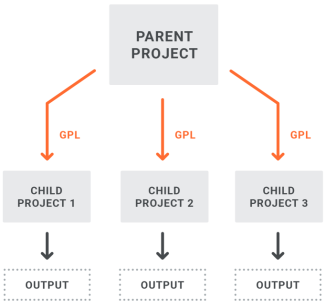By using Global Project Linking, you can import content and project files contained in another Flare project, thus allowing you to maintain the information in one location but reuse it in any other project. With this feature, you can include or exclude particular types of files (e.g., topics, snippets, stylesheets, glossaries, targets), specific individual files, or files that have certain condition tags applied. Simply use the include/exclude methods that work best for you.
This is different than a simple import process, because in this case, the imported files remain linked to the source project. This lets you make future updates to those files in just one place—in the parent project. When you perform ongoing imports using your previous settings, Flare recognizes changes to the source files. Therefore, the new files can be brought over, replacing the outdated ones.

Example You are working on three different Flare projects. Within those projects, you might have 35 topics and 50 images that are identical in the three projects. In addition, you might use the same stylesheet in each project.
Rather than maintaining three different sets of identical files, you can store one set of those files and import them into the individual projects when needed. Here are a couple of options: (1) One option is that you could consider one of your three Flare projects as the "global parent" for those shared files. (2) Another option is that you could create a new Flare project (perhaps naming it "global"); this project could have no other purpose than to serve as a repository for the shared files across your projects. In other words, you would not necessarily generate any output from this parent project, but simply use it as a place to hold your shared information.
When you want to use any of the shared topic, image, or stylesheet files from the global project, you would import them into the child project. This creates a link between the imported files and those in the global project. Therefore, when you edit those files in the future, you would do so from the global project and then reimport the changes (either manually or automatically) to the other child projects.

